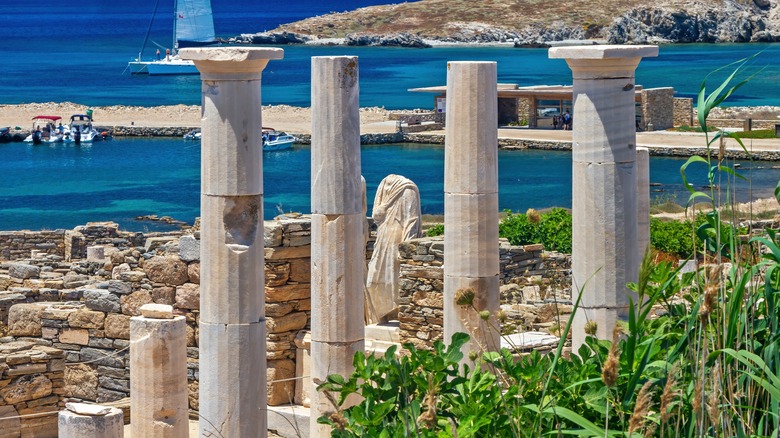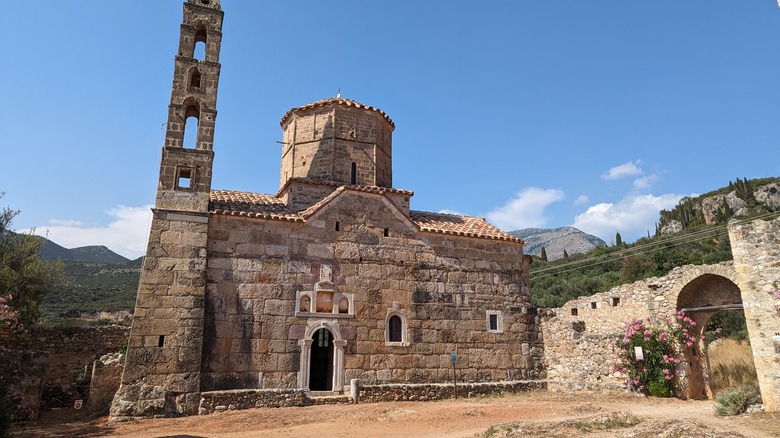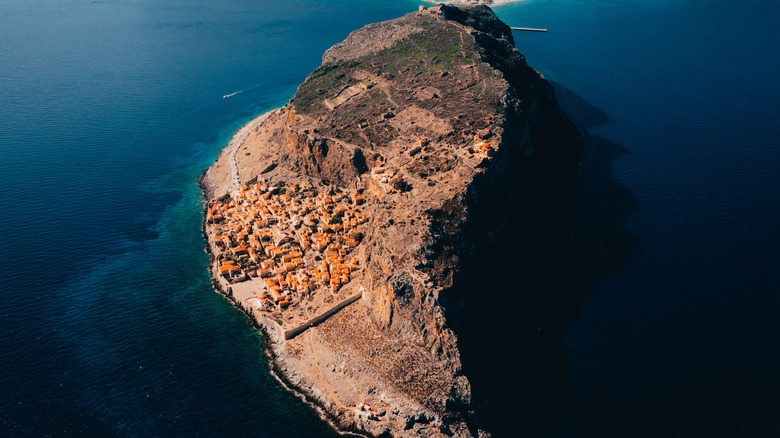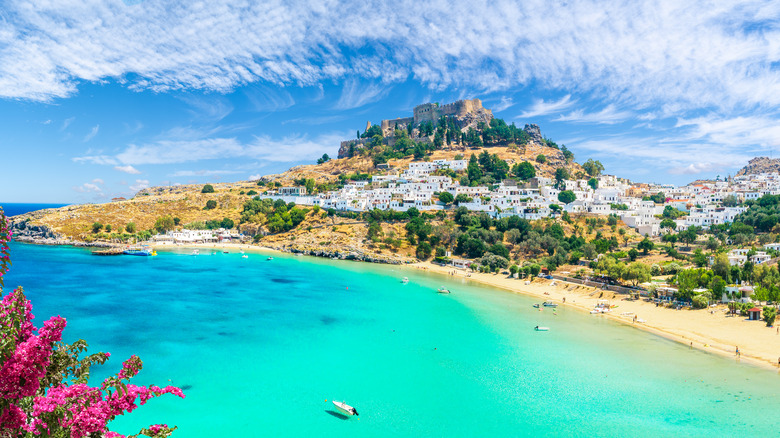The Best Destinations In Greece You Can't Skip On Your Trip, According To Rick Steves
A country of many guises, Greece is a fabulous, year-round vacation destination. It's a land of deep culture with a civilization that goes back a millennia. Greece's landscape is equally impressive, with forests, towering peaks, and, of course, the famous Greek islands. It's the latter, perhaps, that captures the imagination of tourists the most, with the best Greek Islands often recommended by travelers for summer vacation. Spread across the Aegean, Ionian, and Mediterranean seas, like jewels in a vast expanse of clear turquoise, they are a dream come to life.
But the islands aren't the only places worth checking out in Greece, and for travel expert Rick Steves, they are just one of the many multi-faceted draws to the country. There are destinations steeped in deep history and under-the-radar areas that are great for hiking. We've pored over Steves' stories on Greece and pulled together a hit list of the places with which he's fascinated. Having visited a number of them, we couldn't agree more with the choices that the renowned travel expert has made.
Athens
As Steves writes on his website, in Athens, travelers can walk in the "footsteps of the great minds that created democracy, philosophy, theater, and more...even when you're dodging motorcycles on "pedestrianized" streets. Romantics can't help but get goose bumps as they kick around the same pebbles that once stuck in Socrates' sandals, with the floodlit Parthenon forever floating ethereally overhead." There are a lot of marvels around the Greek capital, not least the Acropolis, one of the most famous historical ruins in the world. Records show that people have lived here for more than 3,000 years, and today, it's a beguiling mixture of old and new and ancient and modern.
The section known as the Parthenon, which encloses the historic city core, is like a trip back thousands of years across sites that have stood the test of time. You'll see the Temple of Olympian Zeus, the Theatre of Dionysus, and the Acropolis — the columned highlight of it all, sitting atop a hill. The port of Athens, Piraeus, is the jumping-off point for trips to many of Greece's famed islands. It's also a major transport hub in Europe and the busiest passenger port on the continent.
Delos
This UNESCO World Heritage site has great ruins, and Steves stresses its role in Greek lore. On "Rick Steves' Europe," the travel expert says, "The island of Delos was one of the most important places in the ancient Greek world with temples honoring the birthplace of the twin gods Apollo and Artemis. Centuries before Christ, Delos attracted pilgrims from across the Western world." Mythology posits that Apollo, a pivotal god in the pantheon of deities, was born here, and for eons, worshippers would come to the island to offer prayers.
The island became a trading hub, and the archaeology there shows the vestiges of life here from millennia earlier. The breadth of historical ruins on Delos is something of great wonder, with examples of the Archaic, Classical, and Hellenistic eras all visible. Unlike other Greek islands, Delos is uninhabited and only has its historical ruins and ancient infrastructure for travelers to experience on a day visit.
Delphi
This town was important to ancient Greeks, and you can ski here in the winter and hike in the summer. Many centuries ago, Greeks viewed Delphi as the focal point of the planet, a place where the Earth's intangible power was centered. This explains why it hosted so many places of prayer. It was also the home of the oracle of Delphi, a priestess who served almost as a conduit for the god Apollo. Many people visited from all directions to hear the spiritual wisdom and prophecies of Pythia, as the high priestess was known. Global leaders would also come here to learn what lay in store for them.
Steves ponders the island on his website: "Perched high on the southern slopes of Mt. Parnassos, and overlooking the gleaming waters of the Gulf of Corinth, Delphi is without doubt the most spectacular of Greece's ancient sites." A number of museums at Delphi help to bring history to life. The Archaeological Museum neighbors the archaeological area, while the European Cultural Center of Delphi puts on exhibits of artworks in various mediums. But Delphi isn't just a destination solely rooted in the past. There is more to enjoy there beyond history, from a ski center on the slopes of Mount Parnassus to the many hiking trails around town.
Epidavros
For fans of ancient Greece, this is a destination not to miss. The archaeological site sits in the Peloponnese, a jagged peninsula that spreads across the southern part of the country. On its northeastern side is a place known as Epidaurus, and Steves notes that its highlight is the theater. Built more than 2,000 years ago, the theater was famed for its shows, especially for those that were recuperating — Epidavros was known as a center of medicine and healing.
On his website, Steves writes that the theater "provided entertainment for those who made the pilgrimage here. Given its size (it seated up to 14,000) and obvious lack of modern amplification, the acoustics needed to be perfect. They were...and still are. Sitting in the most distant seat as your travel partner stands on stage, you can practically hear the retsina rumbling in their stomach."
The past comes into the present at the annual summer Athens & Epidaurus Festival, when old plays are performed at the theater. Beyond the dramatic performances, visitors can also find beaches and countryside in the environs. There is also a sunken city near the Methana volcano, where a former settlement was buried after a volcanic eruption. Since this happened close to the coast, the city now sits underwater, making for a great snorkeling expedition.
Hydra
This off-the-radar escape with unforgettable beaches is Steves' favorite Greek island. He describes it as a "glamorous getaway that combines practical convenience (only about two hours by boat from Athens) with idyllic Greek island ambience. Donkeys rather than cars, the shady awnings of well-worn cafés, and memorable seaside views all combine to make it clear...you've found your Greek isle," on his website. Continuing, he handily summarizes Hydra as "an easy blend of stray cats, hardworking donkeys, welcoming Hydriots (as locals are called), and lazy tourists on "island time.'"
The charms of Hydra have not been lost on tourists, and each summer, its waters fill with boats and high-profile visitors. Prior guests have included Sophia Loren and Pablo Picasso. There are fine, large houses dotted around the island, and embarking on sailing expeditions can help you to view them properly. Hydra has hundreds of churches and even a handful of monasteries, which can all be visited. Best of all, for tourists in search of a change of scene, Hydra is a car-free destination — though cruise ships dock there in the summer. For a breathtaking view of the sea and the rocky terrain of Hydra, the stop of Mount Eros, the island's highest point, is a spot not to miss.
Mani Peninsula
Among the many places to visit in this part of the Peloponnese is Kardamyli, a small village on the Mani Peninsula. For Steves, this place embodies Greece's rustic charm and is located at the southern tip of mainland Greece. As he explains on his website, "[I]t really does feel like the end of the road. In the Mani, travelers discover a timeless region of rustic villages and untrampled beaches. Empty, ghostly hill towns cling, barnacle-like, onto distant ridges, still fortified against centuries-old threats." Also written as Kardamili, the village sits on what some call the Peloponnesian Riviera.
It is an area of intense beauty and contrasts, from the deep blue sea to the green undulating hills and batches of cypress trees. There are even mountains visible, sometimes their peaks dusted in snow, and fine sunsets over the Messinian Gulf. From the nation's capital, it can be reached in less than four hours by car. For observers of culture, it's also home to an annual literary festival and a jazz festival.
Monemvasia
Also in the Peloponnese, this island is a sight that's hard to comprehend: a town built on a hulking rock island. Monemvasia was founded by the Byzantines, and its history extends to the sixth century. Walking around this unique destination, travelers can amble over cobbled streets, peer at stone homes that are old and faded or newly restored, and feel like they have traveled back in time. The town's name derives from the Greek "moni emvasi," which means "only access," a reference to the short bridge that is the only way onto the island. The island itself, a mammoth pile of rock, is about 5,000 feet long, about 2,000 feet wide, and rises more than 600 feet in height. It was part of the mainland until an earthquake in A.D 375 separated the two.
This is a fascinating place to wander, as we have had the pleasure of doing. It's also the Greek town perfect for those looking for a couple's getaway. Steves describes Monemvasia on his website as "a gigantic rock that rockets improbably up from the blue-green deep just a few hundred yards offshore, is a time-warp to the medieval Peloponnese ... This remarkably romantic walled town — with the remains of an even bigger Upper Town scattered along the peak high above — is a stony museum of Byzantine, Ottoman, and Venetian history dating back to the 13th century. Summiting Monemvasia is a key experience on any Peloponnesian visit."
Mycenae
This is another archaeological site not to miss. As Steves notes on his website, "A visit to Mycenae is a trip back into prehistory to see some of the oldest remains of a complex civilization in all of Europe. Following the same ancient sandal-steps as the ancient Greeks, today's visitors continue to enjoy Mycenae's majestic setting of mountains, valleys, and the distant sea. Exploring this still-impressive hilltop, you'll discover the famous Lion Gate, a manageable museum, an enormous domed burial chamber...and distant echoes of the Trojan War."
This was the base of the Mycenaean civilization, where Agamemnon, an icon instrumental in the defeat of the Trojans in Greek mythology, was from. Thousands of years before the era of Christ, people lived here. There are remnants of the large palaces, and the complex stone work from thousands of years earlier, and visitors can take it all in with a trip there. They will also see arches, traces of old fortifications, and fountains that attest to the formidable knowledge of the people here.
Mykonos
This lively Cycladic island has chic boutiques and vibrant nightlife. It's also a pretty destination, with stone alleys winding around the main town of Chora, blindingly white homes that contrast with the shimmering turquoise sea, and windmills that turn lazily in the breeze. There are plenty of places to stay here, from expensive, plush resorts to simple inns, as well as jewelry stores and art galleries for people who like to add shopping to their travel. Tourists will also discover castles, museums, churches, and an area known as Little Venice — where local merchants and traders built large homes near the water. Mykonos is a famous Greek Island that certainly lives up to its name.
For a peaceful excursion, head to the town of Ano Mera, which wraps around the monastery of Panagia Tourliani. Steves' feelings about the island are clear on his website. "Mykonos is the very picture of the perfect Greek island town: a seafront village crouched behind a sandy harbor, thickly layered with blinding white stucco, bright blue trim, and purple bougainvilleas. Mykonos' status as a fashionable, jet-set destination and a mecca for gay holiday makers also gives it a certain hip cachet (and sky-high prices) ... The core of town is literally a maze, designed by Mykonians centuries ago to discourage would-be invaders from finding their way."
Nafplio
On his website, Steves is effusive with praise about this Peloponnese spot. "The charming Peloponnesian port town of Nafplio is small, cozy, and strollable. Though it has plenty of tourism, Nafplio is both elegant and proud, retaining a certain genteel panache from its glory days as the capital of a newly independent Greece. It's a must-see because of its historical importance, its accessibility from Athens, and its handy location as a home base for touring the ancient sites of Epidavros and Mycenae." This town is a two-hour drive from Athens and has a mesmerizing old city with winding alleys and vertiginous stairways connecting them. There's also a waterfront with a promenade that makes for fine evening wanders and classic Greek tavernas.
At the beaches, tourists can sun themselves by the day, or explore the town's three castles: Acronafplia, Bourtzi, and Palamidi. Nafplio was the capital of Greece in the early 1800s when it first became a country, and so it holds a special place in locals' hearts. It is named after Nafplios, the son of Poseidon and its founder, and features varied architecture, from Turkish fountains and mosques to Italian-style squares.
Olympia
The famed ancient site is the birthplace of the Olympic Games. Located in the western part of the Peloponnese peninsula, it was a very sacred part of old Greece. Beginning in the year 776 B.C., people from all over Greece came together to compete in sports games, and the Olympic Games were born. Today's Olympia showcases its rich past, with old temples and buildings that were once thriving centers of sporting activity. At the Archaeological Museum of Olympia, aged artifacts include a statue of Hermes and sculpted works that adorned the Temple of Zeus. Each summer, festivals bring an added allure to Olympia. One features live performances, while another is a film festival that focuses on cinematic gems for youngsters.
Writing on his website, Steves lauds Olympia's celebration of its past. "A visit to Olympia — most famous as the site of the original Olympic Games — offers one of your best opportunities for a hands-on antiquity experience. Line up at the original starting line in the 2,500-year-old Olympic Stadium. Visit the Temple of Zeus, former site of a gigantic statue of Zeus that was one of the Seven Wonders of the Ancient World. Ponder the temple's once-majestic columns — toppled like towers of checkers by an earthquake — which are as evocative as anything from ancient times." Even with the crowds, Steves maintains that Olympia is "a magical place, with ruins nestled among lush, shady groves of pine trees."
Rhodes
One of the Dodecanese islands, Rhodes, lies just off the coast of southern Turkey. It's a place of mountain villages and pine forests, as well as some revered historical sites. Steves describes the island aptly in a video. "Rhodes is built upon layers of civilizations — Italian, Greek, and Turkish, with a dash of medieval Crusader lore from all over Europe tossed in. Today, luxury yachts crowd the harbor. The island's main city, also called Rhodes, was one of the great cities of antiquity. The famed statue called the Colossus of Rhodes once towered above the city."
This really is a destination with everything, from beaches backed by mountainous pine forests, ancient sites and monuments, and modern resorts that dot the coast. A visit inevitably starts in the main city, where the old town is fortified and is a proud representation of medieval architecture. This is where you would find an old palace, a lofty clock tower, museums, and churches, all set among snaking alleys. The newer part of the city is more Italian in style, a reflection of the era when Italians governed Rhodes. Beyond this hub, travelers can find buzzing resort areas like Ialysos, ancient monasteries, charming villages, and ruins of former great cities. If you yearn for attractive strips of sand, a thrilling hike will take you to one of Greece's most gorgeous, secluded beaches.
Santorini
One of the most romantic destinations in Greece, Santorini is set on the caldera of a former volcano. Steves declares on his website that "this unique place has captured visitors' imaginations for millennia and might have partly inspired tales of Atlantis. But the otherworldly appeal of Santorini doesn't end with its setting. Perched along the ridgeline is a gaggle of perfectly placed whitewashed villages, punctuated with azure domes that make this, undeniably, one of Greece's most scenic spots. If this place didn't exist, some fantasy painter would have to conjure it up." Santorini is, in reality, a clutch of islands, though the main one is called Thira.
The modern topography of Santorini resulted from a series of volcanic explosions that took place over many thousands of years, causing the volcano's main caldera to collapse and fill with water. That's why the island appears like part of a giant ring. The main town of Fira, set at one end of the caldera ridge, is a sight to behold. It's set hundreds of feet above the sea, with views of water and the island unfurling below. For many visitors, Oia is the most appealing destination, a village of pure, blinding white houses set among the lava rock. The beaches are equally hypnotic, and they come in a variety of shades, with sand that's beige, red, and black at various places around the island. It's also popular, so to avoid foot traffic, visit this gorgeous Greek island instead of overcrowded Santorini.
Methodology
Steves clearly has a soft spot for Greece, and it's no surprise, given how beautiful and varied the country is. Visitors can see natural wonders, and also examples of man's ingenuity and architectural prowess. There are cultural tokens dotted around the lands of Greece and places of pure beauty that will leave a lasting impression on any traveler. We looked over Steves' website and videos and pulled together a list of the places that recurred, which were clearly destinations that he felt should not be missed. We supported his choices with a combination of independently sourced information from tourism boards and travel blogs, as well as our own travels around Greece.














